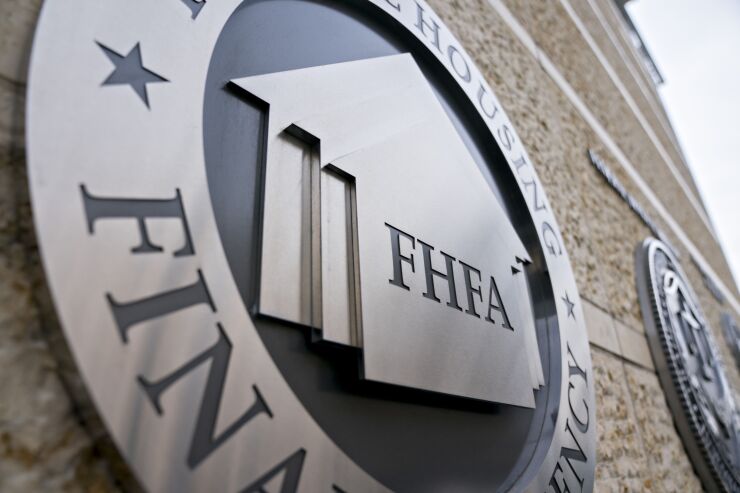
With the Federal Home Loan banks approaching their centennial, it's prudent for their regulator, the Federal Housing Finance Agency,
But I'm concerned about
In September 2022 I had the privilege of speaking at one of the first listening sessions which FHFA hosted for its "FHLBank System at 100" initiative. I noted then that, like my fellow community bankers across the U.S., I'm in the relationship business. Our institution takes in deposits from local individuals, businesses and nonprofits, and then we turn around and lend those dollars back out the same way.
In a perfect world, deposits would fully fund our loans. In reality, there's often a mismatch between loan demand and deposit flows.
FHFA correctly notes in its report the critical way the Federal Home Loan banks very effectively address member banks' liquidity needs; however, it doesn't emphasize the manner in which Federal Home Loan banks also help solve members' duration mismatches.
Typically, depositors like to have their money tied up for as short a time as possible. Often our borrowers want the exact opposite, desiring to lock in financing rates and terms as long as they can. An essential part of a bank's value proposition is being an intermediary for those customers' opposing objectives, but in doing so, banks take on interest rate risk. We don't manage that risk by betting on the direction of interest rates — examples abound of how bad we all are at that. Rather, bankers strive to ensure their institutions' balance sheets are built to withstand whatever unknowable, future interest rate scenarios arise. And sometimes long-term, fixed-rate liabilities — the kind the Home Loan banks provide — are what community banks need to manage their interest rate risk.
I'm uneasy about the possible outcome of FHFA's exploration of "… revising the community bank investment standards that members must meet to maintain access to long-term advances."
Today, there's no other provider which can match the Home Loan banks' simple, on-balance-sheet, inexpensive and reliable solutions for community banks' asset/liability mismatches. That includes the Federal Reserve which, with the sunset of its Bank Term Funding Program, typically won't lend to banks for more than 90 days.
A set of panels discussing minority depository institutions and digitization found that cost is a significant challenge to minority depository institutions, especially in the core processing space.
FHFA notes in its report why it intends to reconsider standards for membership in the Home Loan banks. Some of the examples given seem well reasoned. However, I worry that, should large institutions' membership or borrowing abilities be curtailed, it could result in scale changes at the banks with bad knock-on effects for small banks like mine.
That's because little Century Savings Bank gets the same benefits of the Home Loan banks' borrowing power as anybody else. If I decide to borrow money from the Federal Home Loan Bank of New York today, and so does one of the biggest members in the district, we each pay the same rate of interest. Exactly the same rate of interest.
The active presence of the biggest banks brings huge volume into the Home Loan Bank System and enables them to be in the markets every day. That's an important reason why, as FHFA notes in its report, "(t)he FHLBanks' success in serving their mission is driven by their ability to issue debt at rates only slightly higher than those on comparable U.S. Treasury instruments." And after applying a razor-thin markup, they pass that low-cost funding on to community banks like mine.
A lot of the efficiency and execution-readiness of the Home Loan Bank System has to do with its current scale. I'm concerned that, should FHFA significantly alter larger institutions' membership and/or borrowing standards, those advantages of scale could decrease. If that were to happen, then community banks like mine could pay the price.
I urge FHFA to proceed slowly and carefully with the changes it considers for the system. As my colleague Julieann Thurlow so succinctly put it in these pages two years ago, "don't mess with success."
Century Savings Bank has been a member of the Federal Home Loan Bank of New York for nearly 75 years. They've been a reliable partner to us in good times and bad. Our Home Loan bank has listened to our local community-economic development needs, and created programs in response, like its new 0% Development Advance. When everybody in our industry felt some angst on Sunday, March 12, 2023, I was on the phone that night with Adam Goldstein, chief business officer at the New York bank. Despite a lot of other things happening in New York right then, Adam took the time to talk with me and to make sure that Century Savings Bank would have whatever funding it needed the next day. And I know that community bankers across the U.S. would say the same kind of things about their local Home Loan bank. That's the quality of partner we've got, and the kind FHFA needs to preserve.






